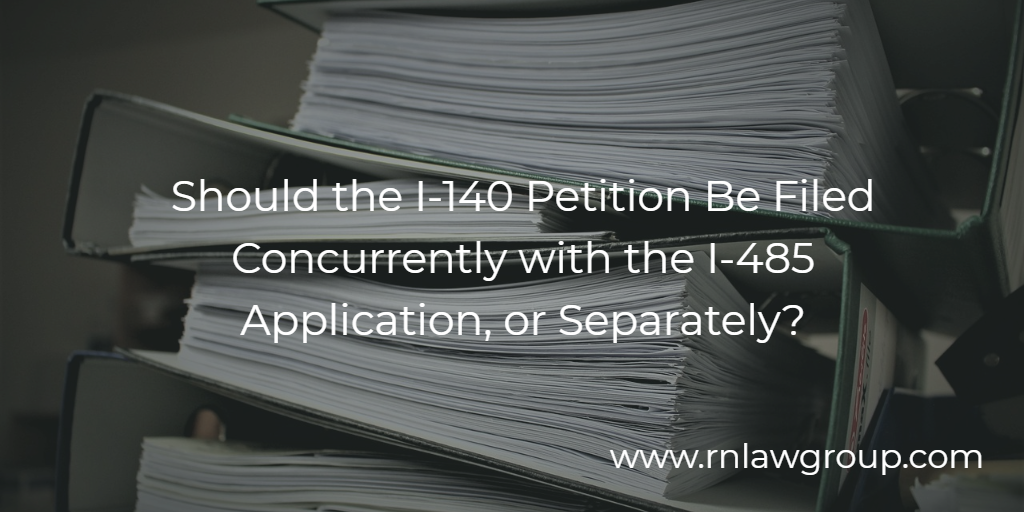
Should the I-140 Petition Be Filed Concurrently with the I-485 Application, or Separately? Pros & Cons
For the employment-based green card process in the EB-2 and EB-3 categories, once the PERM labor certification is approved, the sponsoring employer has 180 days (6 months) to prepare and file the I-140 immigrant petition. If the beneficiary’s priority date is or will be current according to the visa bulletin at the time the I-140 petition will be filed, the applicant has the option of submitting the I-485 adjustment of status application (and those of derivative family members) concurrently with the I-140 petition.
In what situations should the applications be filed concurrently, and when might it be advantageous to file the I-140 and I-485 separately? A lot depends on predictions for upcoming months’ visa bulletins, strength of the I-140 petition, and service center processing times.
Filing Concurrently
The most compelling reason for filing the I-485 applications concurrently with the I-140 petition is uncertainty of being able to apply for adjustment of status later, after the I-140 receipt or approval notice arrives. The Department of State’s visa bulletin is issued monthly, and U.S. Citizenship & Immigration Services, which processes the I-485 application, also decides month-to-month whether it will accept the Filing Dates chart published by the State department, or whether applicants must use the Final Action Dates chart. If an applicant’s priority date enables them to submit the I-485 application in a certain month, it may be prudent to file concurrently with the I-140 petition since doing so is the fastest way to ensure the adjustment of status application is filed within the timeframe that USCIS will accept it. This is particularly relevant if there is a likelihood of retrogression (priority dates moving backwards) in upcoming months’ bulletins, or if the applicant’s eligibility is based only on the Filing Dates chart – even though the Filing Dates chart usually does not move forward or backwards significantly after October, USCIS is more likely to accept applications based on it within the first few months of the fiscal year (October through December).
Another reason to file the I-485 concurrently with the I-140 petition is to expedite receipt of an EAD or Advance Parole document. If the applicant’s current work authorization will expire soon, and they are unable or prefer not to extend it, it is in their best interest to file the I-485 application concurrently with the I-765 as soon as possible, to prevent or minimize a work authorization gap. Likewise, if the applicant has plans for international travel and would prefer to use Advance Parole for re-entry (rather than renewing a visa at a consulate), they may also opt to file concurrently in order to give the I-131 form as much time to process as possible.
Filing Separately
If priority date retrogression or expiring work authorization are not a concern, filing the I-485 separately from the I-140 can be beneficial. If there is any risk of the I-140 petition being denied, it is safer to wait for the I-140 approval before filing the adjustment of status applications, if time allows. If the applications are filed concurrently and the I-140 is denied for some reason, the I-485 applications (of the principal applicant and any derivative family members) would be automatically denied, since they are based on the I-140 petition. The applications could always be re-filed with little prejudice, but would require new I-485 filing fees to be submitted.
In addition to less risk of denial due to potential I-140 denial, filing the I-485 separately could confer the advantage of faster processing at a more efficient service center. Currently, for example, adjustment of status applications filed separately, based on a pending or approved I-140 petition, typically are processed at the National Benefits Center, whereas applications filed concurrently with an I-140 petition are processed at either the Texas or Nebraska Service Centers. Between the three, the NBC processes adjustment of status applications at a much faster pace (within 6 months based on recent observations, if a visa number is available and all required evidence has been submitted) than the TSC or NSC, where cases may be pending 10-20 months.
Applicants and their employers should take into account the factors above when deciding whether to file the I-140 and I-485 applications concurrently or separately. They can consult with an attorney to review the strengths and potential weaknesses of their case and develop a strategy that maximizes the likelihood of a positive and speedy outcome for both applications.
By: Rebecca Chen

